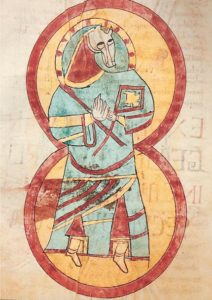Bridwell ms 35
See for description of Bridwell MS 35:
http://www.smu.edu/bridwell/specialcollections/bridwellwesternms/ms35.htm
Christopher De Hamel in his description of The Bible of Wouter Grauwert, in Latin, 1443-45, refers to MS 35 as below:
\ »The mixing of Old and New Testaments is quite unexpected at any period of biblical history, known to us as occurring only, although differently, in the so-called ‘Biblia Irregularis’ of the early thirteenth century [almost certain before 1230], now MS 35 in the Bridwell Library at Southern Methodist University, Dallas.\ »
In his description of the smaller illuminated initials in the Wouter Bible, he states that \ »In addition [to the 13 large historiated initials], there are many large initials which show animals and creatures which are not illustrative of the text as such but are certainly pictorial, such as a jester emerging from a flower and playing two pipes, a wing dragon with a human head, a young woman with the hind legs of a dog …\ » The BI is certainly filled with animals and creatures not illustrative of the text.
Christopher De Hamel looked at the manuscript when he lectured at Bridwell on his last visit and his comment after looking at it for some time, was that he had examined over 3,000 ms., and that he had never seen anything like it, probably not produced in France, evidently written/copied before 1230, and maybe even before 1220.
Several other renowned medieval scholars, including Dr. Larry Ness, are as puzzled about the text as Dr. De Hamel.
I have been worked on the manuscript for the last 5 years and am almost convinced that the BI is of an Alcuin exemplar of the late 10th cent., as many of the variants are from Consensus codicum secundum exemplar Alcuini scriptoriam; Legionessis, Leon, S. Isidoro, codex gothicus. 960 in Hispinia; Toletanus, Madrid, Bibl. Nac, Vitr. 13-1 (Tol. 2-1, s.x. in Hispinia).
Also, the Confessio Esdras, IV Ezra (II Esdras) chapter 8, v. 20-36, is included as a separate text following the end of Nehemiah, which appeared as a separate text for first time in the Codex Legionesis, ca. 960. Which later became a Christian confession of faith! The Gospels follow the Confessio as the last 4 books. The MS in not the result of faulty rebinding as each book follows the previous book on the same folio. The following inscription is of a perplexed 17th century reader: \ »the scribe originally copied them, for reasons yet to be determined, in this strange order.\ » Ownership inscription of the Celestines of Sens, 1681.
And, that the animal/beast images seen in the Eastern textiles hanging in the cathedrals served as the model for the 8 historiated and the 63 floriate initials with animal/beast, beads heads and birds, similar to Gautier Lebaube atelier (i.e., in Branner), smaller initials in red and blue within red and blue with complementary pen work extensions throughout. Illustrations include an Ass playing a harp, an Ass on his hind legs with bells in both front feet, a rabbit playing a harp, only 3 human type figures with weapons (sword, club with shield, and drawn bow), etc. Why else would they be seen in a 12th-13th century bible, with the mingling of the books, void of any Jewish/Christian symbols.
Any suggestions would be appreciated. I can send samples of text and images if interested. I am currently working on a power-point presentation.
Page A. Thomas
Retired, Special Collection
Birdwell Library
Southern Methodist University
Leave a comment
PAGES ANNEXES
Auteur du blog : Jean-Luc DEUFFIC




